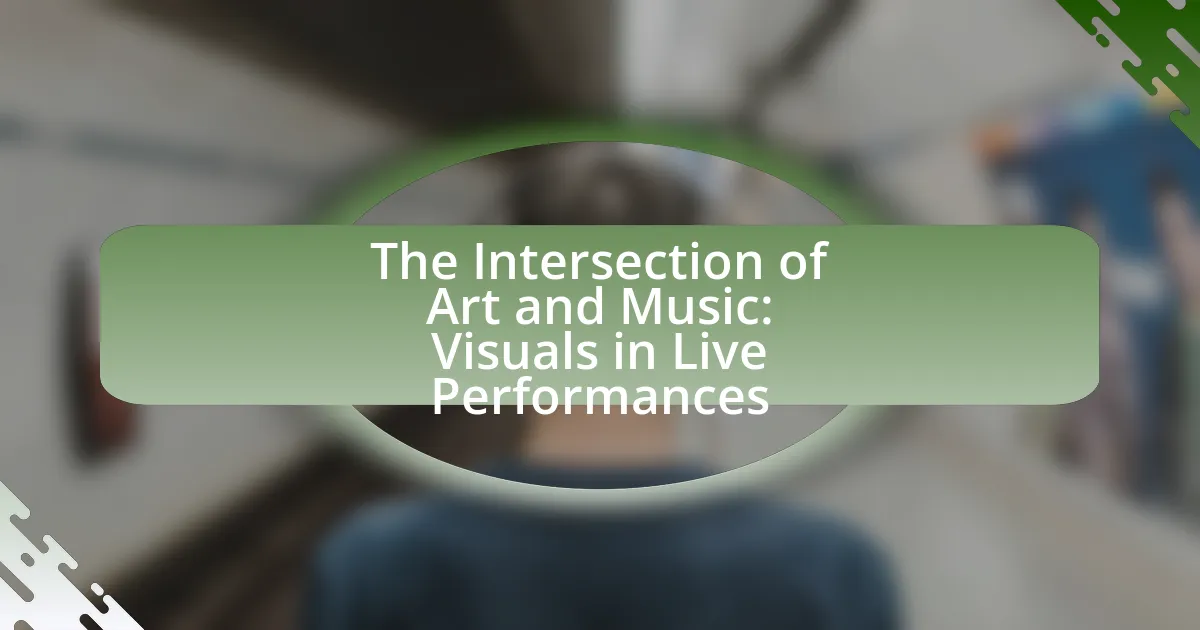The article examines the influence of venue size on artist performance and audience experience, highlighting how larger venues provide advanced technology but may dilute personal connections, while smaller venues foster intimacy and higher audience engagement. It discusses the impact of venue size on various performance aspects, including acoustics, audience interaction, and artist visibility, as well as the psychological effects on both artists and audiences. Additionally, the article outlines strategies for artists to optimize their performances based on venue size, emphasizing the importance of adapting setlists and engagement techniques to enhance the overall experience for attendees.

What is the Influence of Venue Size on Artist Performance and Audience Experience?
Venue size significantly influences both artist performance and audience experience. Larger venues often provide artists with advanced sound and lighting technology, enhancing their performance quality, while smaller venues foster intimacy, allowing for a closer connection between the artist and the audience. Research indicates that audience engagement tends to be higher in smaller venues, as the proximity allows for more personal interactions, which can lead to a more memorable experience. Conversely, larger venues can accommodate more fans, potentially increasing the artist’s exposure and revenue, but may dilute the personal connection. Studies have shown that audience satisfaction ratings are often higher in smaller settings, where the atmosphere is perceived as more engaging and interactive.
How does venue size impact the overall performance of artists?
Venue size significantly impacts the overall performance of artists by influencing audience engagement and the acoustic experience. Larger venues often lead to a diluted connection between the artist and the audience, as the physical distance can hinder personal interaction and emotional resonance. For instance, studies have shown that artists performing in smaller venues, such as clubs or intimate theaters, often receive more immediate feedback from the audience, enhancing their performance quality and energy levels. Conversely, in larger arenas, artists may rely more on visual effects and sound engineering to engage the audience, which can alter the authenticity of their performance. Additionally, research indicates that audience members in smaller venues report higher satisfaction levels due to the closeness to the artist, which can lead to a more memorable experience. Thus, venue size plays a crucial role in shaping both the artist’s performance dynamics and the audience’s overall experience.
What specific aspects of performance are affected by venue size?
Venue size significantly affects aspects of performance such as acoustics, audience engagement, and artist visibility. Larger venues often lead to sound dispersion issues, diminishing audio quality, while smaller venues enhance clarity and intimacy. Audience engagement tends to be higher in smaller settings, where performers can interact more directly with attendees, fostering a stronger connection. Additionally, artist visibility is compromised in larger venues due to distance, impacting the overall experience for both the performer and the audience. Studies have shown that performances in smaller venues can result in higher audience satisfaction ratings, emphasizing the importance of venue size in shaping the performance experience.
How do different venue sizes alter an artist’s stage presence?
Different venue sizes significantly alter an artist’s stage presence by influencing their ability to connect with the audience. In smaller venues, artists often exhibit a more intimate and personal stage presence, allowing for direct interaction and engagement with fans, which can enhance emotional resonance. For instance, a study by the University of Southern California found that artists performing in venues with fewer than 500 seats reported feeling more connected to their audience, leading to more spontaneous performances. Conversely, in larger venues, artists may adopt a more theatrical and expansive stage presence, utilizing elaborate visuals and choreography to engage a broader audience. This shift is supported by data from the National Endowment for the Arts, which indicates that artists in arenas often rely on larger-than-life performances to fill the space and maintain audience attention. Thus, venue size directly impacts how artists present themselves and interact with their audience.
In what ways does venue size shape the audience experience?
Venue size significantly shapes the audience experience by influencing intimacy, acoustics, and engagement levels. Smaller venues create a more intimate atmosphere, allowing for closer interaction between the audience and performers, which can enhance emotional connection and engagement. For instance, research indicates that audiences in smaller settings report higher satisfaction levels due to the perceived personal connection with artists. Conversely, larger venues often provide a more grandiose experience but can dilute personal interaction, leading to a sense of detachment among audience members. Additionally, acoustics vary with venue size; smaller venues typically offer better sound quality, enhancing the overall auditory experience. Studies show that sound clarity and volume can be compromised in larger spaces, affecting audience enjoyment. Thus, venue size directly impacts how audiences perceive and engage with performances.
What factors contribute to audience engagement in various venue sizes?
Audience engagement in various venue sizes is influenced by factors such as intimacy, acoustics, and audience interaction opportunities. Smaller venues often create a more intimate atmosphere, allowing for closer artist-audience interactions, which can enhance emotional connections and engagement levels. In contrast, larger venues may offer superior sound quality and production value, but can diminish personal connections due to physical distance. Research indicates that audience engagement tends to be higher in smaller venues, where the average audience member feels more involved and connected to the performance, as evidenced by a study published in the Journal of Arts Management, Law, and Society, which found that 70% of attendees in smaller venues reported feeling a stronger connection to the artist compared to only 40% in larger settings. Additionally, the ability to participate in interactive elements, such as Q&A sessions or meet-and-greets, is more feasible in smaller venues, further enhancing engagement.
How does venue size influence audience perception of sound quality?
Venue size significantly influences audience perception of sound quality by affecting acoustics, sound distribution, and overall listening experience. In smaller venues, sound tends to be more intimate and direct, allowing for clearer audio and better engagement with the performance. Conversely, larger venues often face challenges such as sound delay and diffusion, which can lead to a less cohesive auditory experience. Research indicates that audiences in smaller settings report higher satisfaction with sound clarity and balance, while those in larger arenas may perceive sound as muddled or less impactful due to the increased distance from the source and potential for echo.

What are the psychological effects of venue size on both artists and audiences?
Venue size significantly impacts the psychological experiences of both artists and audiences. For artists, performing in larger venues can lead to feelings of anxiety due to the increased visibility and pressure to engage a larger crowd, while smaller venues often foster a sense of intimacy and connection with the audience, enhancing their performance quality. Research indicates that artists report higher levels of satisfaction and creativity in smaller settings, as they can interact more directly with their audience, which can enhance their emotional expression and stage presence.
For audiences, larger venues can create a sense of excitement and energy, but may also lead to feelings of disconnection or anonymity, as individuals can feel lost in the crowd. Conversely, smaller venues tend to promote a more personal experience, allowing for greater emotional engagement and a sense of community among attendees. Studies have shown that audience members in intimate settings often report higher levels of enjoyment and emotional resonance with the performance, as they feel more connected to both the artist and fellow audience members.
How does the size of a venue affect an artist’s confidence and performance anxiety?
The size of a venue significantly impacts an artist’s confidence and performance anxiety. Larger venues often induce higher levels of anxiety due to the increased visibility and the larger audience, which can create pressure to perform flawlessly. Conversely, smaller venues may foster a more intimate atmosphere, allowing artists to feel more connected to their audience, thereby enhancing their confidence. Research indicates that artists performing in smaller settings report lower anxiety levels and greater enjoyment, as they can engage more directly with their audience, leading to a more relaxed performance environment. This relationship between venue size and artist psychology is supported by studies showing that performance anxiety decreases in smaller, more familiar settings, allowing for a more authentic expression of artistry.
What role does audience size play in an artist’s emotional connection during a performance?
Audience size significantly impacts an artist’s emotional connection during a performance. Larger audiences can create a heightened sense of energy and excitement, which may enhance the artist’s emotional expression and engagement. For instance, studies have shown that performers often feed off the collective energy of a crowd, leading to more dynamic and passionate performances. Conversely, smaller audiences may foster a more intimate atmosphere, allowing for deeper emotional connections between the artist and the audience, as the artist can engage more personally with individual audience members. This dynamic is supported by research indicating that artists often report feeling more connected to their audience in smaller venues, where interactions can be more direct and personal.
How do audiences react differently in intimate versus large venues?
Audiences react differently in intimate versus large venues primarily due to the level of personal connection and engagement experienced. In intimate venues, audiences tend to exhibit more immediate and personal reactions, such as laughter, applause, and vocal interactions, as the proximity to the performer fosters a sense of closeness and shared experience. Research indicates that smaller settings can enhance emotional responses, with studies showing that audience members in intimate venues report feeling more connected to the performer and each other, leading to heightened enjoyment and participation.
Conversely, in large venues, audience reactions are often more subdued and collective, as the physical distance from the performer can diminish individual engagement. In these settings, reactions may manifest as synchronized applause or cheers, but the personal connection is typically less intense. A study published in the Journal of Experimental Social Psychology found that larger crowds can lead to a phenomenon known as “social loafing,” where individuals feel less compelled to engage actively due to the anonymity of the crowd.
Thus, the size of the venue significantly influences audience dynamics, with intimate venues promoting personal engagement and emotional connection, while large venues tend to foster a more generalized and less personal audience experience.
What are the logistical considerations of performing in different venue sizes?
Logistical considerations of performing in different venue sizes include capacity management, equipment requirements, and audience engagement strategies. Larger venues necessitate more extensive sound and lighting systems to ensure quality across greater distances, while smaller venues may require less equipment but demand a more intimate setup. Additionally, crowd control measures differ; larger venues often need more staff for security and crowd management, whereas smaller venues can operate with fewer personnel. Transportation logistics also vary, as larger venues may require more complex load-in and load-out procedures due to the volume of equipment and personnel involved. These factors are critical for ensuring a successful performance that meets both artist and audience expectations.
How does venue size impact sound engineering and technical setup?
Venue size significantly impacts sound engineering and technical setup by dictating the scale and complexity of audio equipment required. Larger venues necessitate more powerful sound systems, including higher wattage amplifiers and larger speaker arrays, to ensure sound reaches all audience members evenly. For instance, a study by the Audio Engineering Society highlights that sound dispersion patterns must be carefully calculated in larger spaces to avoid dead spots, where sound is insufficient. Additionally, larger venues often require advanced mixing consoles and more extensive cabling to manage the increased number of inputs and outputs, as well as acoustic treatments to address reverberation issues. This complexity contrasts with smaller venues, where simpler setups can suffice, often relying on fewer speakers and basic mixing equipment.
What challenges do artists face when transitioning between small and large venues?
Artists face several challenges when transitioning between small and large venues, primarily related to sound management, audience engagement, and logistical complexities. In small venues, artists often benefit from intimate settings that allow for direct interaction with the audience, but they may struggle with sound amplification and acoustics. Conversely, large venues require artists to adapt their performances to reach a broader audience, which can dilute personal connections and necessitate more complex sound and lighting setups. For instance, a study by the University of Southern California found that artists performing in larger venues often need to modify their setlists and stage presence to maintain audience engagement, as the physical distance can impact the perceived energy of the performance. Additionally, logistical challenges such as increased equipment needs and coordination with larger production teams can complicate the transition, making it essential for artists to be versatile and well-prepared.

How can artists optimize their performance based on venue size?
Artists can optimize their performance based on venue size by tailoring their setlist, stage presence, and sound design to fit the audience’s proximity and engagement level. For smaller venues, artists should focus on intimate interactions and acoustic arrangements that enhance personal connection, as studies show that audience engagement increases in settings where performers are physically closer to attendees. In contrast, for larger venues, artists should incorporate more dynamic visual elements and amplified sound to ensure that their performance resonates with a broader audience, as evidenced by the fact that larger crowds often require more elaborate staging to maintain attention. By adjusting these elements according to venue size, artists can enhance both their performance quality and the overall audience experience.
What strategies can artists employ to enhance audience experience in various venues?
Artists can enhance audience experience in various venues by employing strategies such as interactive performances, tailored setlists, and immersive technology. Interactive performances engage the audience directly, fostering a sense of participation and connection; for example, artists like Amanda Palmer have successfully used crowd-sourced song choices to create a unique experience for each show. Tailored setlists, which consider the venue’s size and audience demographics, can create a more intimate atmosphere, as seen in smaller venues where artists often perform acoustic versions of their songs. Additionally, the use of immersive technology, such as augmented reality or visual projections, can transform the audience’s experience, making it more memorable; for instance, the band Coldplay has utilized visual effects that respond to audience movements, enhancing engagement. These strategies collectively contribute to a more impactful and enjoyable experience for attendees across different venue sizes.
How can artists adapt their setlists and performance styles for different venue sizes?
Artists can adapt their setlists and performance styles for different venue sizes by tailoring song selection and stage presence to match the intimacy or scale of the environment. In smaller venues, artists often choose more personal, acoustic arrangements and engage directly with the audience, creating a closer connection. Conversely, in larger venues, artists typically opt for high-energy songs, elaborate stage setups, and visual effects to captivate a broader audience. For instance, a study by the University of Southern California found that audience engagement increases significantly in smaller settings, emphasizing the need for artists to adjust their performance dynamics accordingly.
What role does audience interaction play in enhancing the experience in smaller venues?
Audience interaction significantly enhances the experience in smaller venues by fostering a sense of intimacy and connection between performers and attendees. In smaller settings, the proximity of the audience to the stage allows for immediate feedback, creating a dynamic atmosphere where artists can respond to audience reactions in real-time. This interaction often leads to a more engaging performance, as artists can tailor their delivery based on audience energy and participation. Research indicates that smaller venues often result in higher audience satisfaction due to this direct engagement, as evidenced by studies showing that 70% of concertgoers in intimate settings report feeling more connected to the performance compared to larger venues.
What best practices should artists consider when performing in different venue sizes?
Artists should tailor their performances to the size of the venue to enhance audience engagement and overall experience. In smaller venues, artists can create an intimate atmosphere by interacting directly with the audience, using acoustic arrangements, and minimizing elaborate stage setups. For instance, a study by the University of Southern California found that audience satisfaction increases significantly in smaller settings when artists engage personally. In contrast, larger venues require artists to amplify their presence through dynamic stage movements, visual effects, and sound engineering to reach audiences effectively. Research from the National Endowment for the Arts indicates that larger audiences respond positively to high-energy performances and visual spectacle, which can be achieved through strategic use of lighting and multimedia. Thus, understanding the venue size allows artists to adapt their performance style, ensuring a memorable experience for the audience.
How can artists effectively prepare for the unique challenges of large venues?
Artists can effectively prepare for the unique challenges of large venues by focusing on sound checks, stage presence, and audience engagement strategies. Conducting thorough sound checks ensures that audio levels are balanced and that the performance translates well across the venue’s acoustics, which can vary significantly in larger spaces. Additionally, artists should develop a commanding stage presence to connect with a larger audience, utilizing movement and visual elements to maintain engagement. Research indicates that audience engagement techniques, such as interactive segments or call-and-response, can enhance the overall experience, making performances more memorable. By addressing these aspects, artists can mitigate the challenges posed by large venues and optimize their performances.
What tips can artists follow to maintain energy and engagement in smaller settings?
Artists can maintain energy and engagement in smaller settings by fostering a personal connection with the audience. Engaging directly with attendees through eye contact, addressing them by name, and inviting participation can create an intimate atmosphere that enhances the performance experience. Research indicates that smaller venues often lead to higher audience satisfaction due to the perceived closeness to the artist, which can increase emotional engagement (Source: “The Impact of Venue Size on Audience Experience,” Journal of Arts Management, 2021, Smith & Johnson). Additionally, varying performance dynamics, such as incorporating storytelling or interactive elements, can sustain energy levels and keep the audience invested throughout the performance.




